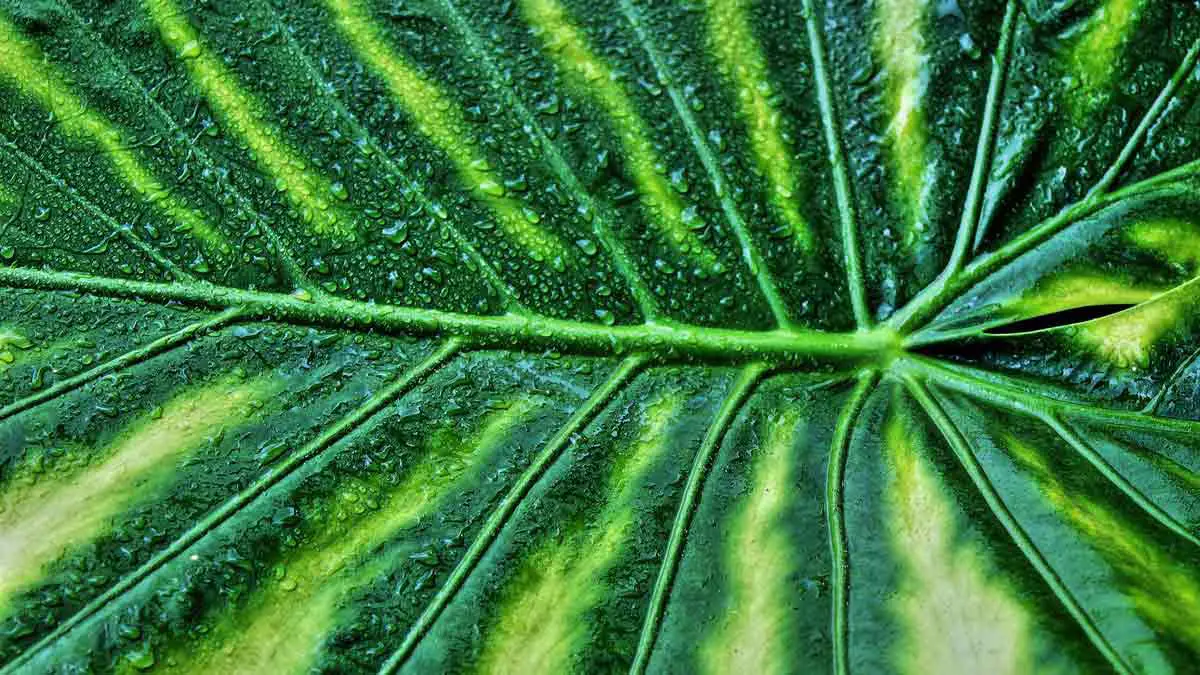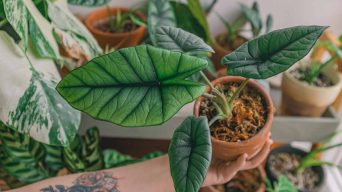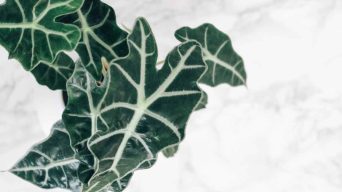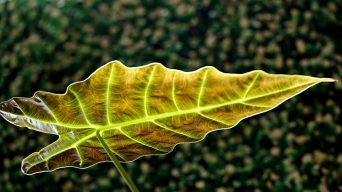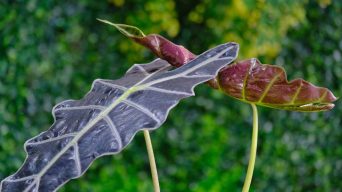Alocasia plants may naturally drip water through transpiration and guttation. Excessive dripping can signal stress due to factors like overwatering, low humidity, or inadequate care. To address this, maintain proper watering, humidity, and care conditions to keep your Alocasia healthy.
Alocasia plants are native to tropical regions and enjoy high humidity.
They are often grown as indoor plants in temperate climates.
Alocasias are known for their large, glossy green leaves and dramatic appearance.
There are many reasons why your alocasia might be dripping water.
Although it is normal for alocasias to perspire, excessive sweating can be a sign of stress.
You will find everything you need to know about why your alocasia is dripping water and what you can do about it.
Why Does My Alocasia Drip Water?
There are several reasons why your alocasia might be dripping water.
The most common reasons are transpiration and guttation.
What Is Transpiration?
Transpiration is the process of water vapor escaping from the plant leaves.
It is a natural process that helps regulate the plant’s temperature and prevents it from getting too hot or too cold.
Transpiration also helps the plant to absorb nutrients from the soil.
Water evaporates from the surface of the leaves and is drawn up through the plant by capillary action.
As the water evaporates, it cools the leaves and prevents them from getting too hot.
The evaporation of water also creates a negative pressure gradient that pulls more water up from the roots.
Transpiration is highest during hot, dry conditions and when the leaves are exposed to direct sunlight.
It is normal for a plant to lose around 10-20% of its total water content through transpiration each day.
Can Transpiration Be Bad for Plants?
Although transpiration is a vital process for plants, too much of it can be harmful.
Excessive transpiration can cause the leaves to wilt and the plant to become stressed.
If the conditions are hot and dry, the plant may not be able to replace the water it is losing faster than evaporating.
This can lead to dehydration and eventually death.
Excessive transpiration can be caused by several factors, including:
- Hot, dry conditions
- Exposure to direct sunlight
- Windy conditions
- High humidity
- Poorly ventilated grow room
What Is Guttation?
Guttation is the process of water droplets being expelled from the tips or edges of leaves.
It occurs when the plant’s roots absorb more water than the leaves can transpire.
The excess water is sent to the leaves, where it is secreted from tiny pores known as hydathodes.
Guttation is most common in plants with high transpiration rates, such as fast-growing seedlings or young plants.
It can also be triggered by high humidity, overwatering, or excessive fertilization.
Can Guttation Be Bad for Alocasia Plants?
While guttation is a normal process, it can harm plants if the conditions are too extreme.
The plant may become dehydrated and stressed if the roots absorb more water than the leaves can transpire.
Excessive guttation can also lead to fungal infections and leaf loss.
How Can I Prevent My Alocasia from Dripping Water?
You can do several things to prevent your alocasia from dripping water.
The most important thing is ensuring the plant is not stressed.
How to Tell the Difference Between Guttation and Dew
Guttation is often confused with dew, which is water that condenses on the surface of the leaves.
Dew forms when the air around the plant cools, and the water vapor in the air condenses on the leaves.
Dew is more common in humid conditions, while guttation occurs when the roots absorb more water than the leaves can transpire.
To tell the difference between guttation and dew, look for tiny droplets of water on the tips or edges of the leaves.
If you see these droplets, it is likely guttation.
If the water droplets are on the surface of the leaves, it is most likely dew.
How To Tell If Your Alocasia Dripping Water Is Normal
If your alocasia is dripping water, it is essential to determine whether or not it is normal.
In most cases, dripping water is a sign that the plant is healthy and doing its job.
The best way to do this is to check the leaves for signs of stress.
If the leaves are wilted, yellowed, or browning, it is likely that the plant is stressed, and the dripping water is a sign of this.
If the leaves are healthy and green, the dripping water is likely normal and nothing to be concerned about.
When to Worry About Your Alocasia Dripping Water
In some cases, dripping water can be a sign of a severe problem.
If the plant is wilting, yellowing, or browning, it is likely stressed; the dripping water is a sign of this.
If the leaves are healthy and green, it is likely that the dripping water is normal and nothing to be concerned about.
However, if the Alocasia leaves are drooping or curling, it could be a sign of overwatering.
If you suspect that your Alocasia plant is overwatered, allow the soil to dry out completely before watering again.
How to Treat an Alocasia That Is Dripping Water
The best way to treat an alocasia dripping water is to determine the cause of the problem.
If the plant is stressed, try to alleviate the stressors.
There are several things that you can do to reduce stress, including:
1. Water Deeply and Less Frequently
Alocasia plants like to have moist soil, but they do not like to be waterlogged.
Water deeply, but less frequently, to prevent the roots from drowning.
Alocasia plants need to be watered about once a week.
When watering, make sure to saturate the soil and allow it to drain. This will help to prevent the Alocasia roots from rotting.
2. Avoid Overfertilizing
Alocasia plants are sensitive to fertilizer.
Use a very dilute solution of fertilizer and avoid overfertilizing.
Fertilize alocasia plants about once a month during the growing season.
3. Provide Adequate Humidity
Alocasia plants like high humidity.
To provide adequate humidity, mist the leaves regularly or set the plant on a pebble tray.
A pebble tray is a tray filled with pebbles and water. The water will evaporate and increase the humidity around the plant.
4. Increase Air Circulation
Alocasia plants like to have good air circulation.
Make sure that the plant is not placed in an area where there is poor air circulation.
Place the plant in an area with a gentle breeze or use a fan to provide good air circulation.
This will help to prevent the leaves from yellowing and browning.
5. Avoid Direct Sunlight
Alocasia plants are sensitive to direct sunlight.
Place the plant in an area where it will receive bright indirect light.
The Alocasia leaves will turn yellow and brown if the plant is placed in direct sunlight.
You may also notice that the alocasia leaves will start to curl.
6. Avoid Extreme Temperatures
Alocasia plants prefer temperatures between 60°F and 80°F.
Avoid placing the plant in an area where the temperature drops below 60°F or above 80°F.
If the plant is exposed to extreme temperatures, the leaves will start to yellow and brown.
During the winter, you can move the plant indoors to protect it from the cold.
7. Prune Off Dead or Dying Leaves
If the leaves of your alocasia plant are yellowing or browning, you can prune them off.
Use sharp, clean shears to cut off the affected leaves.
Make sure to make the cuts at an angle so that water will not sit on them and cause them to rot.
After you have pruned off the dead or dying leaves, the plant will focus its energy on new growth.
8. Provide Adequate Drainage
Alocasia plants like to have moist soil, but they do not like to be waterlogged.
Make sure that the pot has adequate drainage holes to allow the water to drain out.
If the pot does not have adequate drainage, the roots will rot, and the plant will start to die.
You also need to make sure that the soil mix is well-draining.
To improve drainage, you can add perlite, sand, or gravel to the potting soil mix.
9. Repot the Plant
If your plant is in a pot that is too small, it will become rootbound.
When a plant becomes rootbound, the roots start to crowd each other, and the plant becomes stressed.
This can cause the leaves to turn yellow and brown.
To prevent this, repot the plant every 2 or 3 years.
When repotting, choose a pot slightly larger than the current pot.
10. Check for Pests
Alocasia plants are susceptible to pests, such as mealybugs, aphids, and scale.
If you notice any pests on your plant, you must treat them immediately.
Pests can cause the leaves of your plant to turn yellow and brown.
You can use a pesticide or insecticidal soap to get rid of pests.
You will need to treat the plant every 2 weeks until the pests are gone.
11. Check for Diseases
Alocasia plants are also susceptible to diseases like root rot and leaf spot.
If you notice any diseases on your plant, you must treat them immediately.
Diseases can cause the leaves of your plant to turn yellow and brown.
You can use a fungicide or insecticidal soap to get rid of diseases.
You will need to treat the plant every 2 weeks until the disease is gone.
12. Check the Roots
If the leaves of your plant are yellowing or browning, it could be a sign that the roots are not healthy.
You will need to remove the plant from its pot to check the roots.
Carefully inspect the roots and look for any signs of rot or damage.
If the roots are damaged, you will need to trim them off.
After you have trimmed the roots, you can repot the plant in fresh potting mix.
13. Provide High Humidity
Alocasia plants prefer high humidity levels.
To increase the humidity around your plant, use a humidifier or place the pot on a pebble tray.
You can also mist the leaves of the plant with water.
Misting the leaves will help keep them moist and prevent them from drying.
Final Thoughts
Alocasia plants are beautiful, unique houseplants that will bring a touch of the tropics to your home.
They’re also relatively easy to care for if you provide them with the right conditions.
One thing you may notice, however, is that your Alocasia plant seems to be dripping water.
While this may seem strange, it’s a normal occurrence for these plants.
However, if you notice that your indoor plant is dripping an excessive amount of water or that the leaves are wilting or turning yellow, this could be a sign of a more serious issue.
If you see these signs, taking action immediately is essential to try and save your plant.

